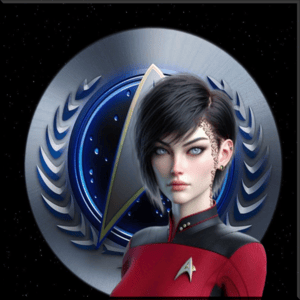Ensign Kaplan had hoped that the current set of crises—refugees onboard and a passenger attempting to claim political asylum—would mean that his standing Monday 1130 appointment with Captain Lancaster on one of the ship’s weapons ranges would be canceled. He didn’t have any moral scruples about using a weapon, but he never liked any situation where his lack of skill was so evident. The large, heavy doors parted, and Kaplan arrived precisely on time, finding Lancaster already there. The components of a Type-1 phaser were arranged neatly on a metal table.
“Good morning, Captain,” Kaplan said, approaching his boss and coming to a respectful parade rest. He cleared his throat. “I would understand, sir, if we had other tasks to accomplish today and you’d rather postpone this lesson.
Lancaster chuckled, nodding to the phaser. “We can walk and chew gum at the same time, Ensign. Show me what you remember about phaser maintenance,” he said.
The yeoman pursed his lips as he stepped up to the table and began quickly identifying the different components of the weapon. Power cell. Emitter assembly. Targeting matrix. Another power cell? And another emitter assembly? He glanced over at the captain with a frown when he realized that there were parts for more than one phaser there; a dirty trick. He could tell, though, that the pieces were not all the same size, and so he quickly sorted them into what he thought were type-I and type-II piles. He found the body of each weapon and inserted the power cells into the matching slots in the bodies, followed by the targeting and trigger assembly and then the emitter matrix.
“Done,” Kaplan announced, knowing that despite the added complexity of the task, he’d memorized the successful assembly of all three main types of Starfleet handheld phaser types.
Lancaster picked up the smaller of the two weapons and pointed it at the far bulkhead. He tapped the trigger on the top of the phaser, but all it did was make a sad beep.
“Evidently not,” Lancaster chided, setting it back on the table.
Kaplan let out a noise of audible frustration as he took the case back off the type-I; he quickly saw that the targeting assembly was upside down. When he removed it, he saw that the tab that would have prevented him from installing it incorrectly had been purposefully removed. The captain was deliberately trying to throw him off and was doing so quite successfully.
“In the field, components can easily become damaged—or even manufactured incorrectly—so you can’t rely on ergonomic aids in the casing,” Lancaster said.
“Yes, captain. Sorry, sir,” Kaplan replied, fixing the one in his hand as Lancaster picked up the other phaser.
The type-II weapon worked perfectly, a blue beam on the stun setting connecting with the back wall as soon as the captain aimed and fired. Lancaster looked at it, turning it over in his hands for a moment before setting it back on the table.
“Good,” Lancaster said before picking up the repaired type-I and moving towards the circular stage in the center of the room to take his spot on the blue hemisphere. Kaplan grabbed the slightly larger pistol and joined him on the other side of the range. “Computer, set cooperative defense mode, level 2,” he ordered.
“Confirmed. Defend the green spheres,” the computer replied. A moment later, the space around them was populated with a set of green spheres, and then a countdown clock appeared going down from 15 seconds. “Begin,” it said, producing a rainbow of smaller spheres swarming around the green ones.
Kaplan was used to just having to keep track of his own color—yellow—and only shooting those targets. Now, it was much more complicated to hit everything except the green ones. He at least liked that he wasn’t competing against the captain for once. The first target he hit was red, and then he missed a shot at a purple one that collided with a green sphere and destroyed it. Cocking his head over his shoulder, he saw Lancaster successfully defend one of his spheres.
“Focus on your half, Connor,” Lancaster reminded him.
The match lasted for five minutes, which were five minutes of anxiety for the yeomen as he got about a 50% defense rate when all was said and done. He was sure there was a lesson embedded there in being able to recognize and respond appropriately to targets, but he didn’t have much time to think about that as he played. In the last minute of the game, the number of targets seemed to double, which in some ways made it easier to score hits but also meant that Kaplan ended up taking out a green sphere by mistake—the equivalent of shooting a hostage during a rescue attempt—which lowered their overall score.
“Match concluded. You have earned an 81% success rate,” the computer reported at the end.
“Not bad,” Lancaster noted, holding his phaser down at his side as he turned to look at Kaplan.
“Only if our scores are aggregated together, sir,” Kaplan replied, shaking his head. “I don’t think I’ll be joining one of the hazard teams any time soon,” he added.
“Marksmanship is your weakest aptitude area, and that’s why we’re spending so much time on it,” Lancaster said. Kaplan’s field promotion to ensign had come with the requirement that he meet the same standards that academy graduates had, including qualifications in marksmanship that he wasn’t required to have as an enlisted yeoman. The captain had taken it upon himself to play the role not only of a boss but now a professor. “You’ll only get better by practicing.”
Kaplan nodded. “And there’s no getting out of this?”
The captain chuckled. “No, I’m afraid not.”
Captain Lancaster looked as though he were about to order another round, but his commbadge chirped, sending a sigh of relief through Kaplan.
“Armstrong to Captain Lancaster. Could you join me on the bridge? I’ve found something quite interesting that I think you’ll want to see,” the ship’s science officer asked.
“On my way, Commander,” Lancaster replied, tapping his badge to end the call.
“Aw, shucks,” Kaplan said, snapping his fingers theatrically.
The captain arched an eyebrow, and Kaplan immediately understood that his moment of glee would cost him like it had so many others before him; he’d never been on the receiving end of one of Lancaster’s creatively punitive whims.
“I was almost going to let you come with me. Lancaster to Bowens,” he said, tapping his badge again.
Kaplan arched an eyebrow at that call. What could Lancaster have in mind?
“Bowens here, Captain,” came the reply quite quickly.
“Ensign Kaplan is here with me on Phaser Range 2. I have other business to attend to, so I want you to continue our lesson. He’s just volunteered himself for hazard training,” Lancaster ordered.
Kaplan’s jaw dropped, and he kicked himself for planting that seed in the captain’s head. Bowens had a reputation for being just as much a stickler for protocol and regulation as Lancaster was, but with even less of a sense of humor and a penchant for intense physical training. He knew that it wasn’t worth pointing out that hazard duty was volunteer only, since he bet that the actual training was something he didn’t have a choice in, even if he didn’t end up serving with one of the teams. This was not how he thought his morning was going to go.
“Aye, sir,” he replied.
“Don’t go easy on him, Commander. Lancaster out,” the captain said, making eye contact with Kaplan before ending the call. “Cheer up, Connor. If you pass out, he’ll probably let you spend the rest of the shift in sickbay,” he said, patting Kaplan on the shoulder before exiting the range and leaving the ensign to his fate.

 Bravo Fleet
Bravo Fleet









